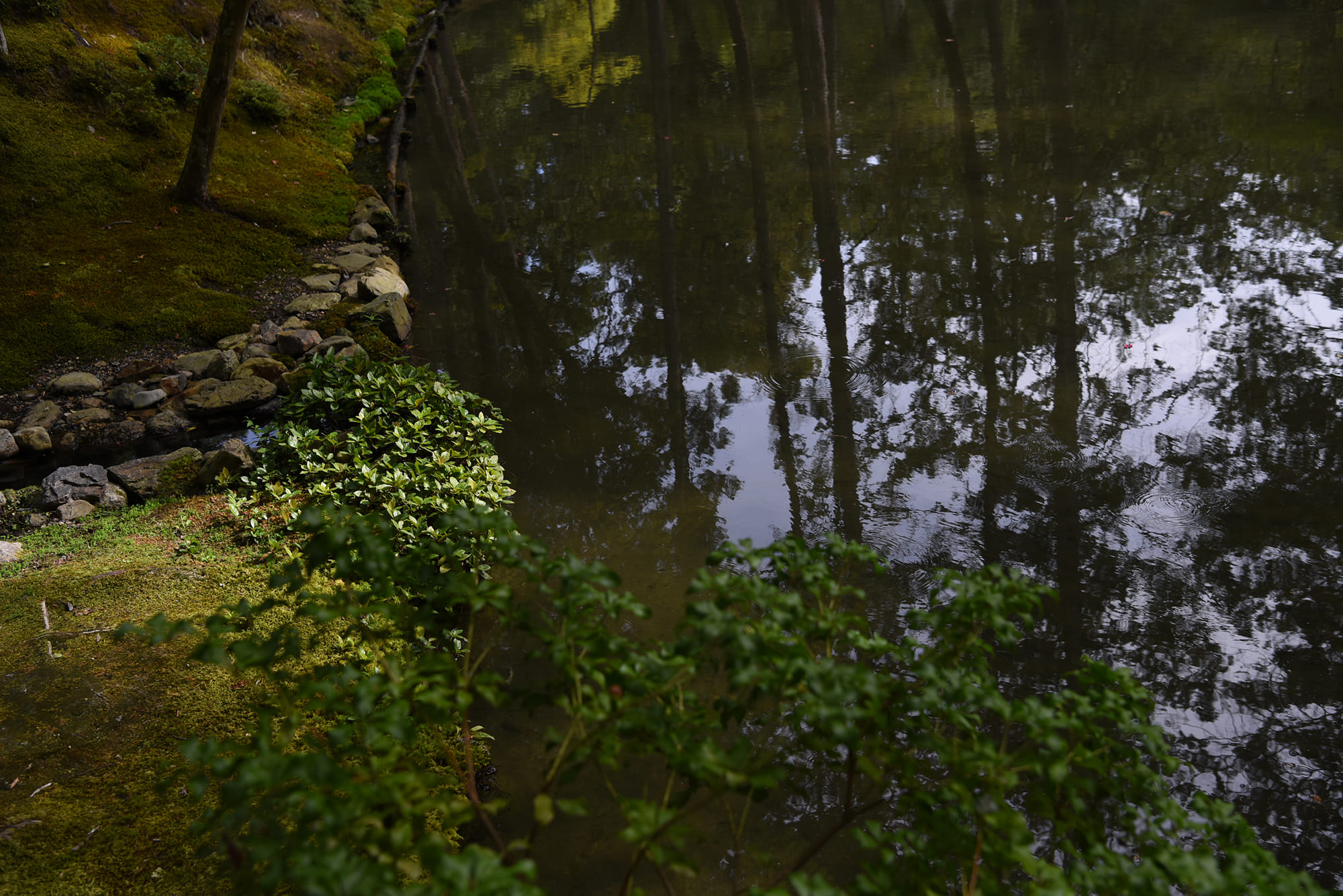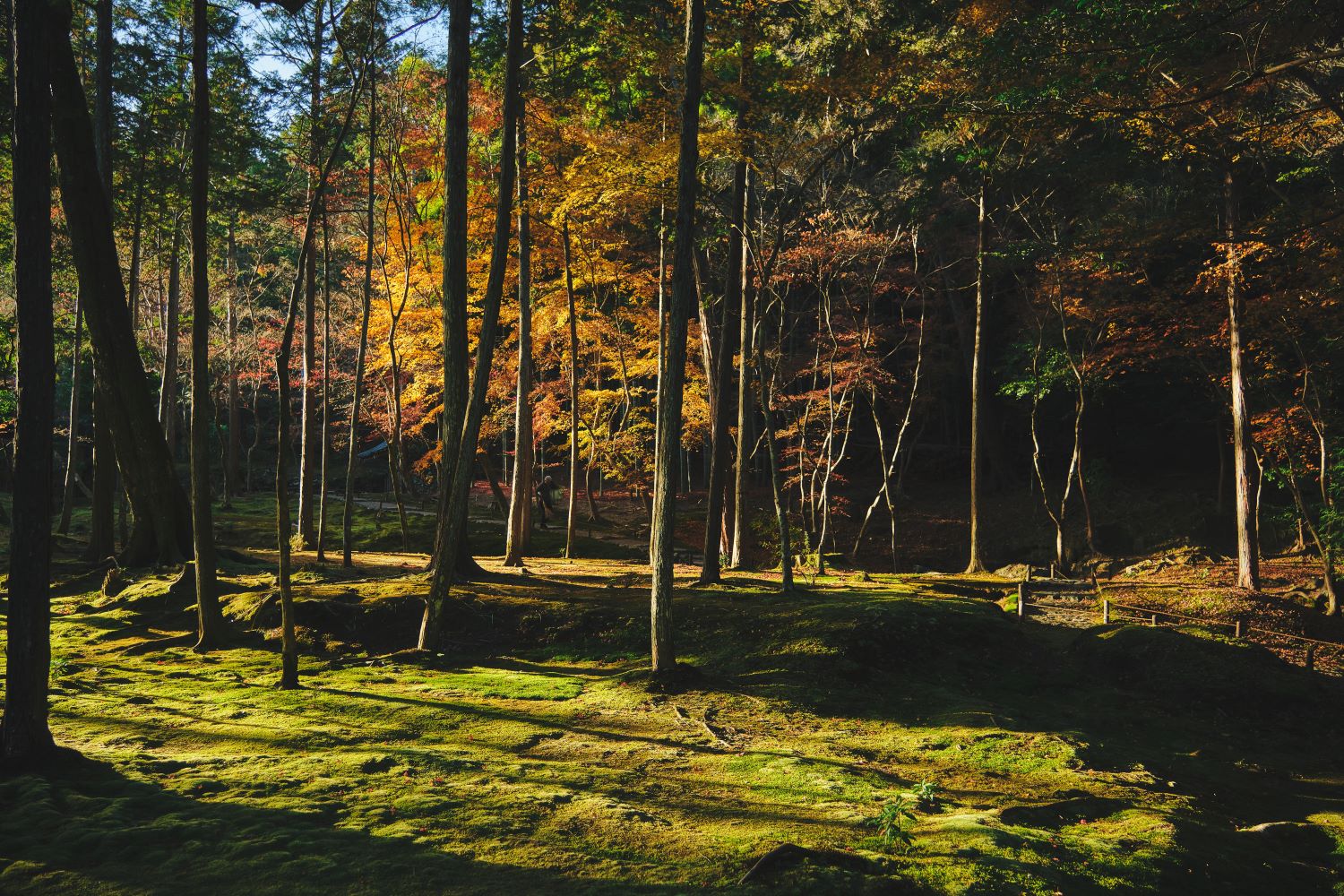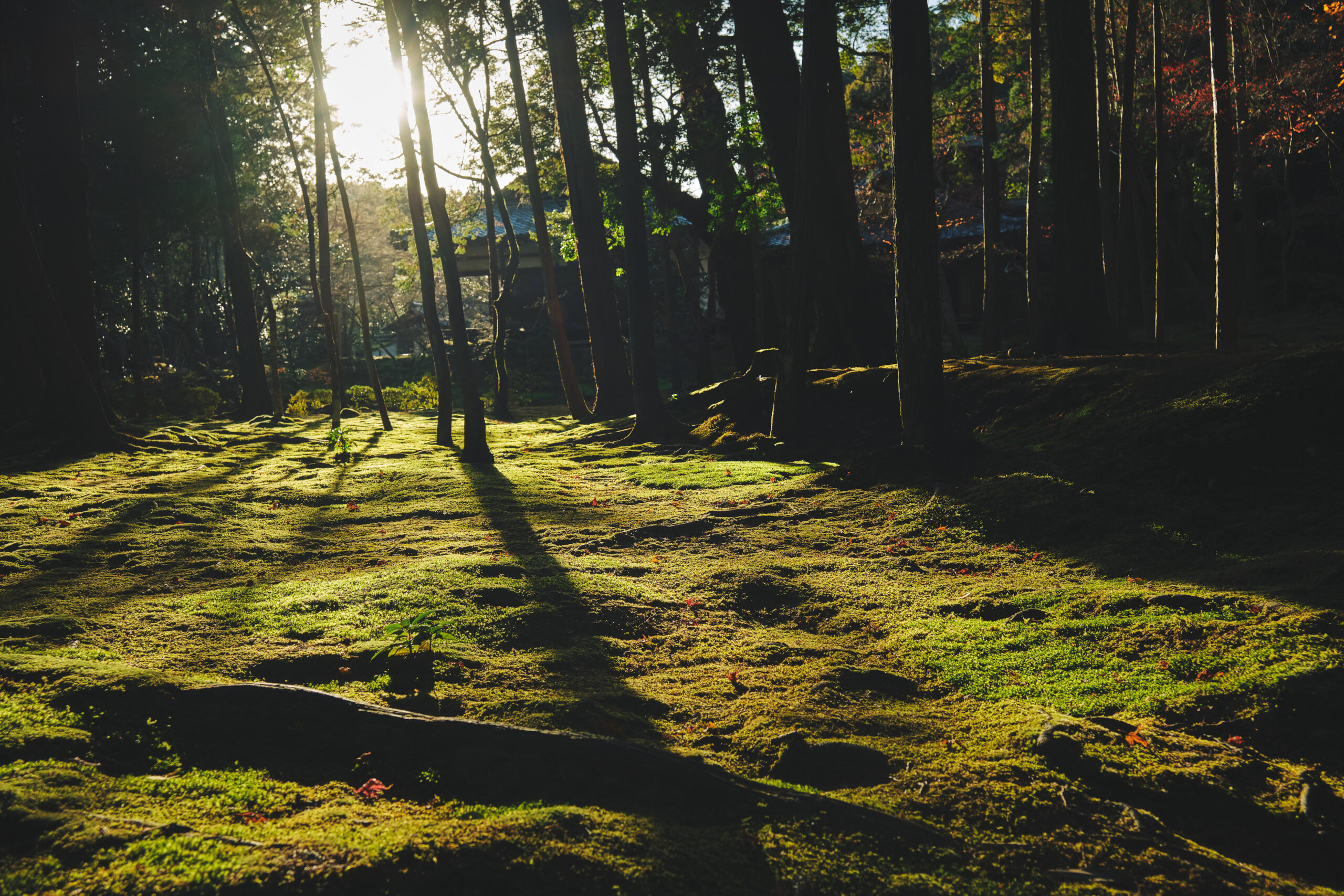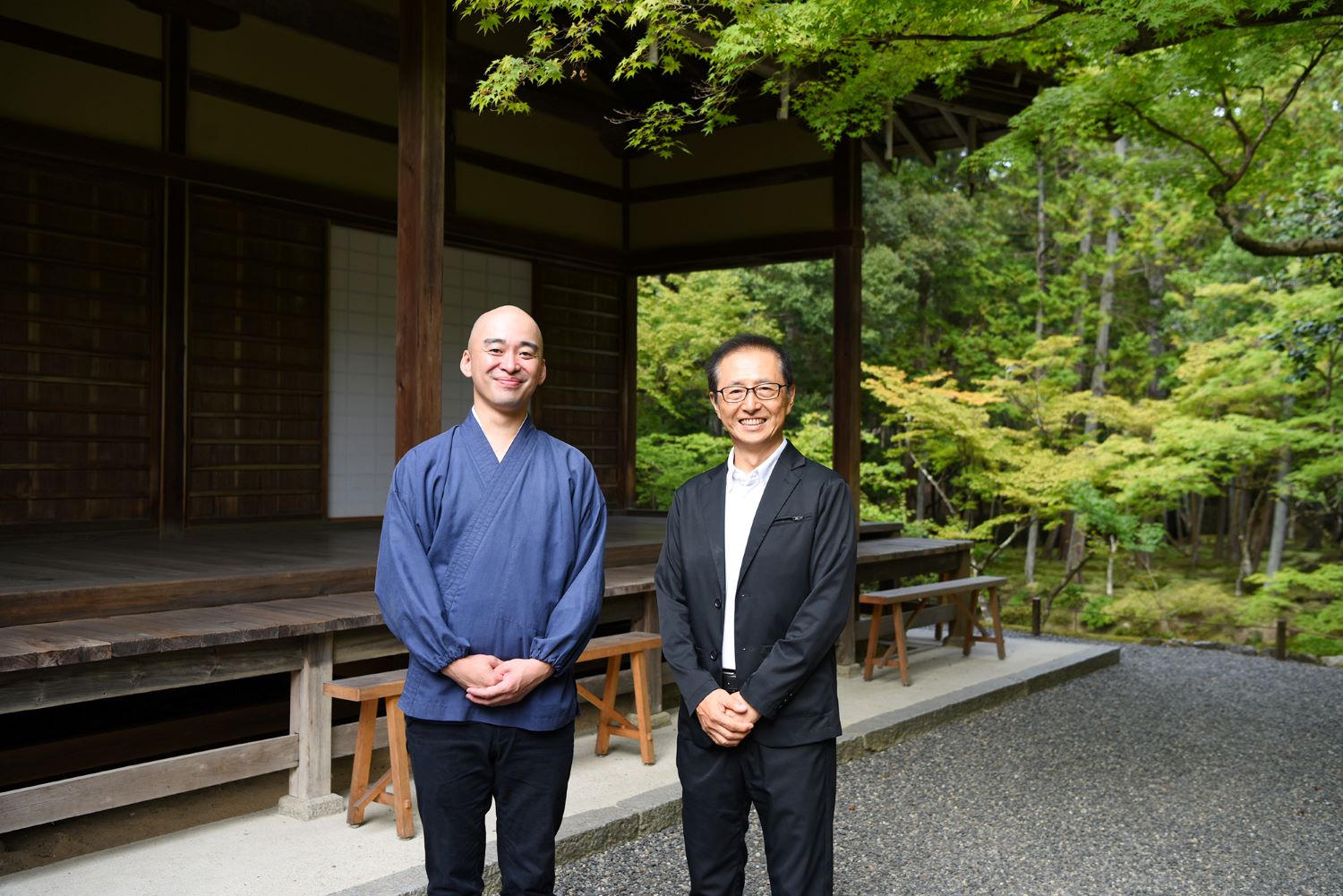2025.7.20
体露金風 西芳寺第十五景
ピーター・J・マクミラン
(翻訳家・詩人)
翻訳者であり詩人でもあるピーター・マクミラン氏が、西芳寺の魅力を綴る「体露金風 西芳寺」シリーズ。日本文化への造詣が深いピーター氏の感性と深い洞察が誘う、心の旅。ぜひ原文の美しい響きも、ご堪能ください。
黄色であっても緑であっても
今回の訪問は、夏の真っただ中。どこもかしこも暑く身にこたえます。ここ数年、夏のような暑さは約5ヵ月間にも及び、5月から10月末まで続きます。このような過酷な状況では、京都の庭園を維持するのも、とにかく大変です。西芳寺も、庭師の方々が年中休むことなく、お庭の手入れに全力を注いでいますが、例外ではありません。
先日、夏の西芳寺の苔を見てがっかりしていた人がいるという話を聞きました。苔が期待していたほど青々としていなかったからです。ですが、もし苔についてもっと理解をしていれば、がっかりとはしなかったでしょう。
苔は、夏の暑さを乗り越えられるよう進化してきた、ユニークな植物の一種です。本来の意味での根や茎や葉の代わりに、葉状体と呼ばれるシンプルで葉に似た構造を持ち、それを使って光合成や繁殖を行います。他の植物とは異なり、苔には水分や養分を体内に巡らせる仕組みがありません。
苔は、干ばつや猛暑をはじめとした過酷な天候を乗り越える方法を発達させてきました。そのひとつが、休眠です。休眠とは、苔が代謝活動を抑える状態のこと。特に、夏に見られます。気温が上がったり水分が不足したりすると、苔は成長を止め、休眠状態に入ります。これにより苔は活力を温存し、好ましい天候条件に戻るまで生き延びることができるのです。
苔が夏に休眠に入るきっかけは、複数あります。もっとも一般的なのが乾燥で、水分がなくなり乾ききった状態です。気温が上がり湿度が下がると、苔の水分は葉から抜けていきます。その結果、苔は縮み、緑の色合いが弱まってゆきます。これが、苔が休眠状態に入ろうとしているサインです。ほかの要因は、日照時間の長さです。どちらの場合も苔は縮んで黄色味を帯び、参拝者が不満を感じてしまうことがあります。
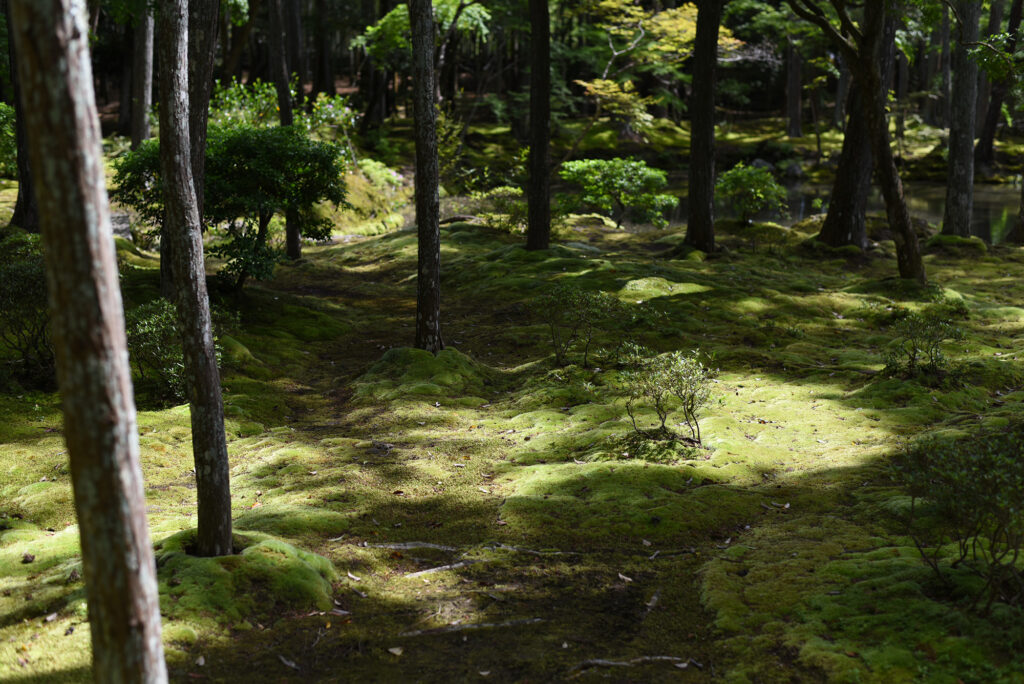
天候がより穏やかになる頃、苔は休眠状態から目を覚まし、再び成長を始めます。このためには、気温が下がり湿度が上がる必要があります。もしくは、日照時間が短くなると、苔が日々の日光の変化に応じて活動を再開する場合もあります。一年のある時期において、休眠が苔に必要不可欠であるという理解は、苔を鑑賞し、この愛らしい植物を保護し保全していくためには欠かせません。
自分自身の観点でお庭に目を向けても、目先の満足感や、足を運ぶためにかかった料金と時間に見合う体験を求めるだけになるかもしれません。しかし、苔を理解したうえでお庭を見ると、最も厳しい状態に適応し生き抜く圧倒的な力に、心底驚くでしょう。そして、苔がほかと一線を引いているわけではなく、複雑な自然界の一部として生きていることに気づくでしょう。苔の生き様は、その時々に私たちを取り巻く環境の状況について、多くのことを教えてくれます。
不満を感じる原因は、結局のところ、私たち自身にあるのです。というのも、事前に確かめていれば、休眠は夏の苔にとっては自然なことだと知っておけたでしょうし、もし青々とした苔が見たいのであれば、違う時期に来ればよいのですから。それどころか、私たちは夏の苔を違った角度から見つめ、感動するかもしれません。繊細ながらも生き抜く力を持つ存在として目を向け、黄色く変化することの賢さに気づくのです。
ですが最終的には、苔は黄色であっても緑色であっても、常に美しい。多くの人がそう理解するようになるでしょう。苔をどう見るかは、人生における多くの出来事をどう捉えるかを表します。ですから、新たな視点で世界に目を向けてみてください。もし自然の何もかもが醜いと感じるのなら、もう一度目を向けてみましょう。そして、すべてが美しく見え始めたのなら、それはあなたが正しい視点で世界を見ている証拠なのです。
Whether it be Yellow, Whether it be Green….
Today it is the middle of summer and everywhere is hot and uncomfortable. In recent years the summer season is almost five months from May to the end of October. It is very hard to maintain the condition of gardens in Kyoto in these extreme conditions. And that is also true for Saihoji where the gardeners who put in all their efforts to maintain the garden in good condition throughout the year.
Recently, I heard that some visitors to Saihoji in the summer expressed their disappointment to see the moss because it was not as green as they had imagined it would be. But I feel that if they understood more about moss, they would not be disappointed.
Mosses are a unique group of plants that have adapted to survive the heat of summer. Instead of having true roots, stems, or leaves, they have simple, leaf-like structures called phylloids that are used for photosynthesis and for reproduction. Unlike other plants, mosses do not have ways of transporting water and water nutrients throughout the plant.
They have developed ways to survive drought, intense heat and other extreme weather conditions and one of these ways is through a process called dormancy. Dormancy is a state in which the mosses reduce their metabolic activity especially during summer. Both rising temperatures and decreasing humidly can cause the mosses to stop growing and enter this dormant state. Doing so allows them to conserve energy and survive until the weather conditions become conductive again.
There are a few different ways that mosses enter dormancy during the summer. One of the most common is through desiccation, which means to lose water or dry out. When temperatures rise and humidity decreases, mosses lose water through their leaves. This causes the mosses to shrink and become less green, a sign that the moss is entering into a dormant state. Another cause of dormancy can be caused by responding to longer daylight. Both cases make the mosses look shrunken and yellowish, which is the cause of the visitors’ disappointment.
When weather conditions become more temperate, mosses will come out of their dormant state and start growing again. For this to happen the temperatures must cool down and humidity increase, or it can occur when days become shorter, and moss responds to changes in daily sunshine. Understanding that dormancy is essential for moss at certain times of the year is one of the keys to admiring moss and helping in the protection and preservation of these lovely plants.
If we look at the garden from our own point of view, we may just look for immediate gratification and some kind of compensation for all the money and time we spent to go there. But if we look at the garden from the mosses point of view, we will admire it so much for its amazing ability to adapt and survive in the most challenging conditions. And we will realize that the moss is not something separate from everything else but part of a complex natural world and its state of being tells us many things about the condition of the environment around us at each moment.
The cause of our disappointment thus lay in ourselves because if we had properly checked, we would have already known that dormancy is natural for moss in summer, and we will know that if we want to see green moss, we can choose a different time of year. Moreover, we will come to admire the moss in a different way, as a sensitive survivor and realize how clever it is to turn yellow.
But most of us will come to understand that moss is always beautiful, whether it be yellow, whether it be green. And the way we look at moss is a paradigm for the way in which we look at so many things in our lives. So let’s look at the world anew, and if everything in nature still looks ugly, then look again. And if all of nature starts to look beautiful then you will know you are looking in the right way.
Peter MacMillan ピーター・J・マクミラン
翻訳家・詩人。株式会社 月の舟(制作・翻訳会社) 代表取締役。
2008年に英訳『百人一首』を出版し、日米で翻訳賞を受賞。2016年9月には英訳『The Tales of Ise』(伊勢物語)、2017年には英訳『One Hundred Poets One Poem Each(新訳)』の2冊がPenguin Booksより出版される。近著に『日本の古典を英語で読む』『英語で味わう万葉集』など著書多数。2019年より朝日新聞にて「星の林に」、2022年より京都新聞にて「不思議の国の和歌ワンダーランド 英語で読む百人一首」を連載。

翻訳:福田安奈


